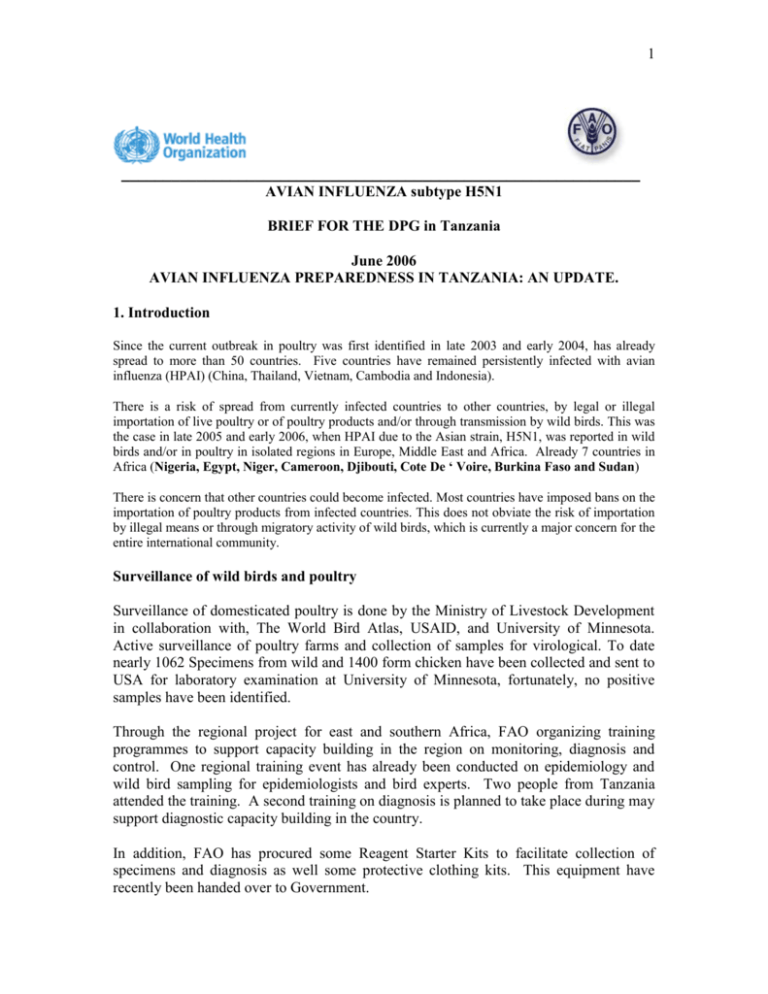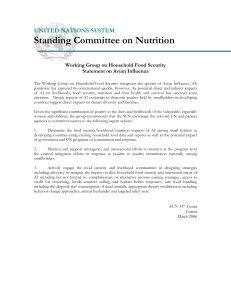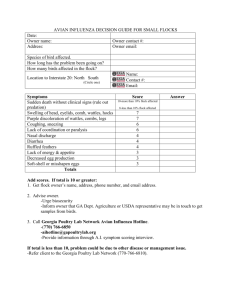1 AVIAN INFLUENZA subtype H5N1 BRIEF FOR THE DPG in
advertisement

1 ______________________________________________________________ AVIAN INFLUENZA subtype H5N1 BRIEF FOR THE DPG in Tanzania June 2006 AVIAN INFLUENZA PREPAREDNESS IN TANZANIA: AN UPDATE. 1. Introduction Since the current outbreak in poultry was first identified in late 2003 and early 2004, has already spread to more than 50 countries. Five countries have remained persistently infected with avian influenza (HPAI) (China, Thailand, Vietnam, Cambodia and Indonesia). There is a risk of spread from currently infected countries to other countries, by legal or illegal importation of live poultry or of poultry products and/or through transmission by wild birds. This was the case in late 2005 and early 2006, when HPAI due to the Asian strain, H5N1, was reported in wild birds and/or in poultry in isolated regions in Europe, Middle East and Africa. Already 7 countries in Africa (Nigeria, Egypt, Niger, Cameroon, Djibouti, Cote De ‘ Voire, Burkina Faso and Sudan) There is concern that other countries could become infected. Most countries have imposed bans on the importation of poultry products from infected countries. This does not obviate the risk of importation by illegal means or through migratory activity of wild birds, which is currently a major concern for the entire international community. Surveillance of wild birds and poultry Surveillance of domesticated poultry is done by the Ministry of Livestock Development in collaboration with, The World Bird Atlas, USAID, and University of Minnesota. Active surveillance of poultry farms and collection of samples for virological. To date nearly 1062 Specimens from wild and 1400 form chicken have been collected and sent to USA for laboratory examination at University of Minnesota, fortunately, no positive samples have been identified. Through the regional project for east and southern Africa, FAO organizing training programmes to support capacity building in the region on monitoring, diagnosis and control. One regional training event has already been conducted on epidemiology and wild bird sampling for epidemiologists and bird experts. Two people from Tanzania attended the training. A second training on diagnosis is planned to take place during may support diagnostic capacity building in the country. In addition, FAO has procured some Reagent Starter Kits to facilitate collection of specimens and diagnosis as well some protective clothing kits. This equipment have recently been handed over to Government. 2 Surveillance in Zanzibar: Hundreds (260 out of 300) of chicken died in Zanzibar in March 2006 but investigations revealed Gumboro as the cause. 2. The National Multisectoral Plan: This plan has now been completed and it will concentrate on five key areas: I. II. III. IV. V. Capacity for early detection and reporting improved Capacity to Contain AI problem at source is established Opportunities for human infection are reduced Tanzanian Public awareness against HPAI improved Improved understanding of Avian Influenza epidemiology The total cost of the National Avian Influenza Emergency Preparedness and Response Strategic Plan is estimated at USD 25,294,188. Surveillance activities being allocated USD 4,625,520, Laboratory diagnostic capacity building being given USD 2,447,900, Reducing opportunities for human infection being allocated USD 6,189,000 Public & Technical awareness creation being allocated USD 3,232,600. The plan will be under the overall management of the Prime Minister’s office, but day to day implementation will be coordinated by the Ministry of Livestock Development. Implementation of day to day activities will be directed by senior staff from Ministry of Livestock Development, Ministry of Health and Social Welfare and the Ministry of Natural Resources and Tourism. At Regional and District Level, the plan will be executed using the existing Government structures. The Regional and District Disaster Management Committees will be Local Command Centres 3. The Health Sector Preparedness Plan for Avian Influenza. This plan is a component of the National Multisectoral Preparedness Plan. Because the health sector started preparing its plan earlier, it has evolved as an entity and therefore has a budget of its own. However the mobilization of resources will be done as part of the overall Government’s Multisectoral Plan. The budget is as follows: Preparing for an emergency………………………. 150,000USD Surveillance…………………………………………... 600,000USD Case investigation and treatment…………………..... 100,000USD Preventing spread of the diseases in the community...1,200,000USD Increase public awareness on Avian Influenza……….. 550,000USD Maintaining essential services………………………. 1,000,000USD Research and evaluation…………………………….. 100,000USD Implementation, testing and revision of the plan…… 50,000USD Laboratory strengthening……………………………. 100,000USD Grand total .. 3,850,000USD 3 4. Surveillance in humans: The Relevant Activities undertaken to date. The public is being alerted on the current situation of Avian Influenza through press releases and official statements and also the mass media have been carrying out messages prepared by the MOH. Health Workers e.g. District Medical Officers have been sensitized in various forums. The MOH has alerted all Districts to be watchful. A ban on importation of poultry and poultry products from affected countries has been recommended and export of live birds and bird products is not recommended at this moment. Laboratory WHO has arranged the services of KEMRI Laboratory in Kenya and the National Institute of Communicable Diseases in South Africa for examination of Human specimens if cases occur. The Ministry of Livestock Development has nearly completed building a modern laboratory at its HQ in Keko. When completed and equipped it has the potential of doing AI virology work. USAID has agreed to equip the lab. 5. USAID Support: USAID has awarded US$ 700,000 cooperative agreement to the University of Minnesota to support Avian Influenza activities in Tanzania both in human and animal surveillance and laboratory capacity development. USAID has also provided additional US$ 50,000 to strengthen human Avian Influenza surveillance, building on IDSR activity they had supported earlier as a collaborative venture involving the partners for Health Reform plus Project (PHRplus) and the Tanzania National Institute for Medical Research (NIMR): Project Objectives; Strengthen capacity of the Ministry of Livestock Development to investigate and confirm AI in poultry and wild birds Establish the capacity to test for AIV in human and bird populations . Build capacity of the NIMR and Central Veterinary Laboratory (CVL) to conduct Human Influenza Surveillance in Tanzania, Integrating the system with the Integrated Disease and Response System. The project will target NIMR. This is a unique project never done before in Tanzania and possibly in Africa. It will identify trends in human influenza virus infections over time through a hospital based sentinel surveillance system, with laboratory confirmation of cases beginning with three hospitals, Muhimbili and two others that will be identified latter. Build capacity to conduct Surveillance for Avian Influenza Viruses in Tanzania’s wild aquatic and shore bird populations.






